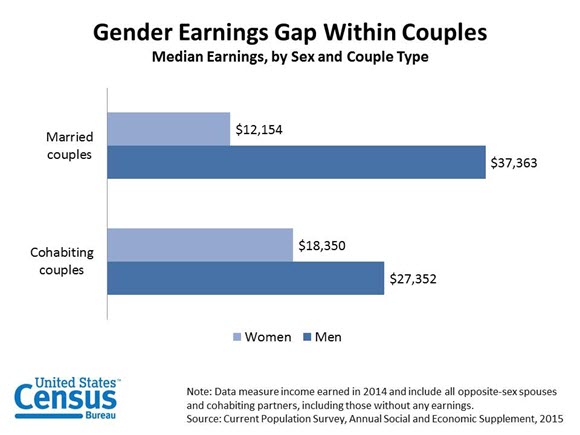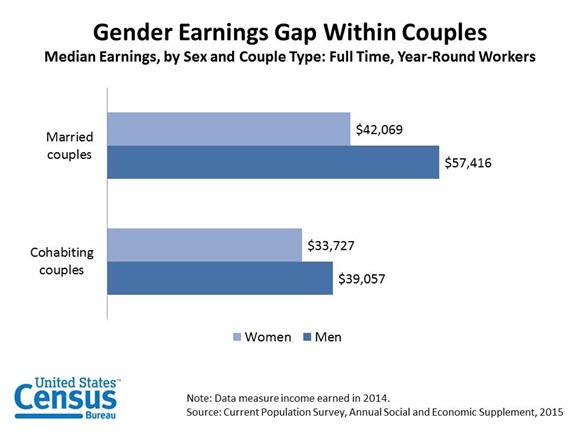
An official website of the United States government
Here’s how you know
Official websites use .gov
A .gov website belongs to an official government organization in the United States.
Secure .gov websites use HTTPS
A lock (
) or https:// means you’ve safely connected to the .gov website. Share sensitive information only on official, secure websites.
-
//
- Census.gov /
- Random Samplings /
- Another View of the Gender Earnings Gap
Another View of the Gender Earnings Gap
Another View of the Gender Earnings Gap
In 2014, the female-to-male earnings ratio stood at 0.79, indicating that the median earnings of women who worked full time, year-round was 79 percent of what their male counterparts earned.
It is also important to note that these values for median earnings compare all spouses and all unmarried partners, including those without any earnings. Although the earnings gap is often calculated only for those working full time, year-round, looking at all couples is valuable when using a family perspective. Many family factors affect men’s and women’s opportunities and decisions regarding whether and how to pursue a career. See the second figure for values comparing only those who worked full time, year-round. Wives working full time, year-round earn a median of $42,069, or 73 percent of the median earnings of similarly employed husbands, $57,416. The median earnings of cohabiting women working full time, year-round is $33,727, or 86 percent of the median earnings of similarly employed cohabiting men, $39,057.
Indeed, employment status is a key factor for understanding the earnings gap within couples. One reason that women earn less, on average, than their husbands or male partners is that they more frequently take time away from the workforce. Although both the wife and husband are employed in nearly half (48 percent) of married couples, it remains more common for the husband to be employed and the wife to be out of the labor force (22 percent) than vice versa (7 percent). Indeed, 96 percent of stay-at-home married parents are mothers [XLS <1.0 MB].
Employment patterns also help explain why earnings are more comparable between male and female cohabiters than between husbands and wives. Compared with married couples, both partners are employed in a larger share of cohabiting couples, at 57 percent. Similar to what was observed for married couples, it is more common for men in unmarried couples to be employed and for women to be out of the labor force (17 percent) than for women to be employed and for men to be out of the labor force (8 percent). However, the gap is smaller than for married couples.
For more information on America’s families and living arrangements, including the similarities and differences [XLS <1.0 MB] between husbands and wives [XLS <1.0 MB] and women and men [XLS <1.0 MB] in unmarried couples [XLS <1.0 MB], please visit today’s release.
Share
 Yes
Yes
 No
NoComments or suggestions?


Top


